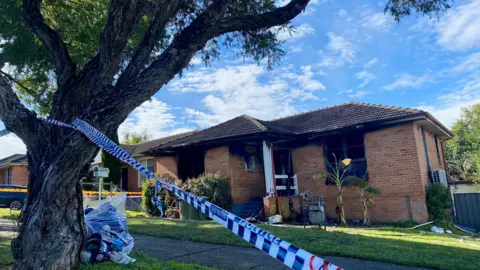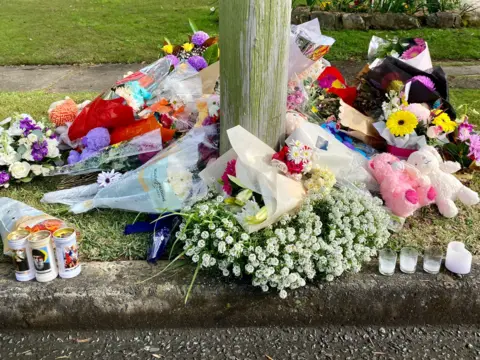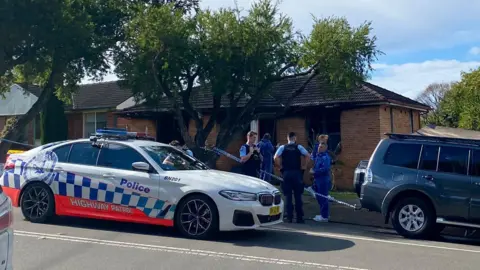By Hannah Ritchie, BBC News, Sydney
 BBC
BBCThe night comes back in fragments: the sound of exploding glass, the frantic call made to police, the tiny shivering bodies emerging from the flames.
Eve’s hand shakes as she pieces it together. She is sitting in her living room in Western Sydney, the burnt-out blackened shell of her neighbour’s house – now a crime scene splashed across Australia’s national news – visible through the blinds.
What happened on this quiet street in the early hours of Sunday morning is hard to reconcile.
A fire that would leave three children dead – including a 5-month-old baby girl – and four more hospitalised alongside their mother.
And a stunning allegation: that this horror – so evident in the wreckage left behind and on the faces of those who witnessed it – was inflicted on these children by their father, who then blocked their attempts to flee.
New South Wales Police are treating the Lalor Park house fire as a domestic violence-related multiple homicide, and the state’s premiere has said the 28-year-old father of seven would face “the most serious charges on offer”.
The case, which has sparked mass outrage, comes while Australia is already in the grips of a self-declared “national crisis” of domestic and family violence – a child is dying at the hands of a parent almost once a fortnight, according to research.
Prime Minister Anthony Albanese has offered a flurry of reforms and funding to stop the scourge.
But he conceded on Tuesday – in response to string of alleged killings this week – that the country “has a long way to go” to turn the tide: “Again, we have seen lives stolen, futures torn away. Every death is its own universe of devastation.”
A ‘deep wound’
Eve – who has asked to have her name changed due to safety concerns – still can’t come to terms with what happened.
“We feel ashamed, we didn’t know there was a baby inside”, she told the BBC, erupting in tears as she begins offering a timeline of the fire.
Somehow, she “blames herself” for the deaths of the children across the road because she didn’t notice the inferno sooner, didn’t call emergency services fast enough.
And yet, her actions were both brave and consequential.
She and her husband were alerted to the violence unfolding by another neighbour, Jarrod Hawkins, who came to their home looking for reinforcements.
Mr Hawkins said he had been woken by a “loud pop” shortly before 01:00 local time (15:00 GMT). Worried his car might be being broken into, he went outside, and immediately saw the flames.
He says he ran across the road without thinking and tried to beat the door down.
 ABC
ABCIn the moments that followed Mr Hawkins would crawl into the house repeatedly to pull out three children – two young boys aged four and seven, and a girl aged nine.
An 11-year-old would eventually be rescued by police, along with two boys aged two and six found in a critical condition, who died a short time later in hospital.
Mr Hawkins then woke up Eve and her family who phoned the authorities.
Soon, Eve’s husband was on their neighbour’s lawn, trying to put out the blaze with a fire extinguisher. Eve helped usher some of the children from the scene – doing her best to calm them and keep them warm as they adjusted to the freezing air outside.
She remembers one of the boys saying blankly at one point: “He tried to kill me”.
Another rescuer would later tell a local paper they heard a similar remark from several of the tiny survivors: “Dad tried to kill us”.
But it was an innocent exchange Eve shared with the four-year-old who escaped, as he looked back at the charred remains of his home, that stays with her.
“He just kept asking whether his toys would be safe inside.”
As emergency services started to take control of the scene, Eve took her cue to leave.
One of the final things she witnessed was “police carrying the Dad out, who was in his underwear”. She would soon learn that the 5-month-old girl had died before rescuers could attempt to revive her.
Speaking to media later Sunday morning, Detective Superintendent Danny Doherty alleged the children’s father had tried to stop “police, responders and neighbours” from entering the burning house, “with the intention of keeping the kids inside”.
“At this stage it does appear the 28-year-old is responsible for multiple deaths of young lives that have been tragically taken away,” Det Supt Doherty added.

Now, a makeshift memorial lies on Freeman Street. The colourful flowers and cards offering messages of support stand in stark contrast to the police tape and forensics tent.
Members of the community described the children as “lively”, “outgoing” and “polite”.
“They were known to a lot of people – those kids were unreal, great manners… full of energy, just typical kids,” Mr Hawkins had earlier told ABC News.
“They were happy,” another neighbour says simply. An elderly resident watches masked investigators sift through their house. Choked by tears, he literally can’t speak about his memories of the family.
Premier Chris Minns has described the tragedy as a “deep wound on the state” that will be widely felt.
“These children deserved a loving home with safety and security – instead, they’re gone,” he added, promising that those who remain would get the support they needed.

‘Determined to end this violence’
Filicide – when a parent intentionally kills their child – is the second most common form of domestic homicide in Australia.
Experts have suggested the nation’s figures are higher than comparable countries, such as the UK and Canada.
In most cases, the families have a history of child abuse, intimate partner violence, or both, says a recent study by the national research organisation for women’s safety.
State and federal governments have begun investing in prevention – which means examining the social drivers of violence – early intervention, bolstering crisis response networks, and supporting families as they recover. And Australia’s latest budget set aside A$1 bn (£526m; $673m) to assist with those aims.
“My government is determined to end this violence. Together, we can make this change. We must,” Mr Albanese said on Tuesday, flagging a previous commitment to build 720 emergency safe houses by 2027 to accommodate women and children fleeing abuse.
Critics though, have described the measure as a “drop in a very large ocean of need” – saying the money being spent doesn’t match the scale of the crisis.
“[This] will accommodate at most a mere 3% of women and children seeking housing. Moreover, waiting three years for these facilities to be built is cold comfort to women and children being killed by family and domestic violence now,” Larissa Waters, the Senate leader for the Australian Greens said.
The four children and their mother who survived the unimaginable events at Lalor Park are in a stable condition, while their father remains in an induced coma, under police guard.
On Tuesday, authorities closed off the street so that the 29-year-old woman could be given a few quiet moments to grieve in private – as she took in the sight of her now unrecognisable home.
Dressed in black, with a hospital band visible on her wrist, she picked up cards and floral tributes, as loved ones held her close.

































